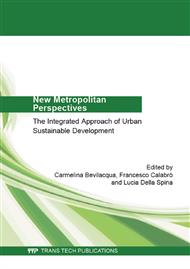p.338
p.344
p.351
p.356
p.364
p.376
p.380
p.386
p.392
Territorial Milieu as Driver for Sustainability through Urban Regeneration Initiatives: The Case of San Diego, CA
Abstract:
Urban regeneration acquired a powerful role in the shaping of the future role of the cities in the Globalization era. It could be considered a public action in a market governed by different powers introducing a more strategic approach in the contemporary urban planning theory and practice. The main features of urban regeneration regard: area-based approach, strong awareness of what are local needs/urban problems, strategic approach and effects/impacts of initiatives. Since integration can be considered one of the main objective to get through urban regeneration, and the complexity as well as the peculiarity of urban dynamics are very much related to the context they belong to, we might see the community involvement as crucial toward sustainable urban regeneration initiatives. The shift of urban regeneration processes toward an increase of the community importance generates different urban management tools based on the typology of partnership set up. The intent of generating wider effects in terms of economic development at macro-level (regional thereby) trough urban regeneration initiatives has been eluded by the strong local interests even if not homogenous among each others. In order to reach a feasible consensus among all actors involved, the common objective became the job creation to which converge all different urban problems and solutions. Consequently, the sustainability of urban regeneration initiatives is still at the centre of politicians and academic debate. Economic sustainability, environmental sustainability and social sustainability provide criteria for such indicators to measure the urban regeneration performance. The paper reports some interesting findings of the second year of the CLUDs research project, funded by IRSES Marie Curie Actions, illustrating how territorial milieu can reinforce local urban regeneration initiatives by combining the latest urban rural link research with the detailed analysis of 9 urban areas located in San Diego, CA (USA), in which urban regeneration initiatives have been implemented. The CLUDs project has introduced the concept of milieu to offer a different source of sustainability within urban regeneration initiatives that is the connections with the surrounding rural areas to reinforce local economy.
Info:
Periodical:
Pages:
364-375
Citation:
Online since:
June 2014
Permissions:
Share:
Citation:


